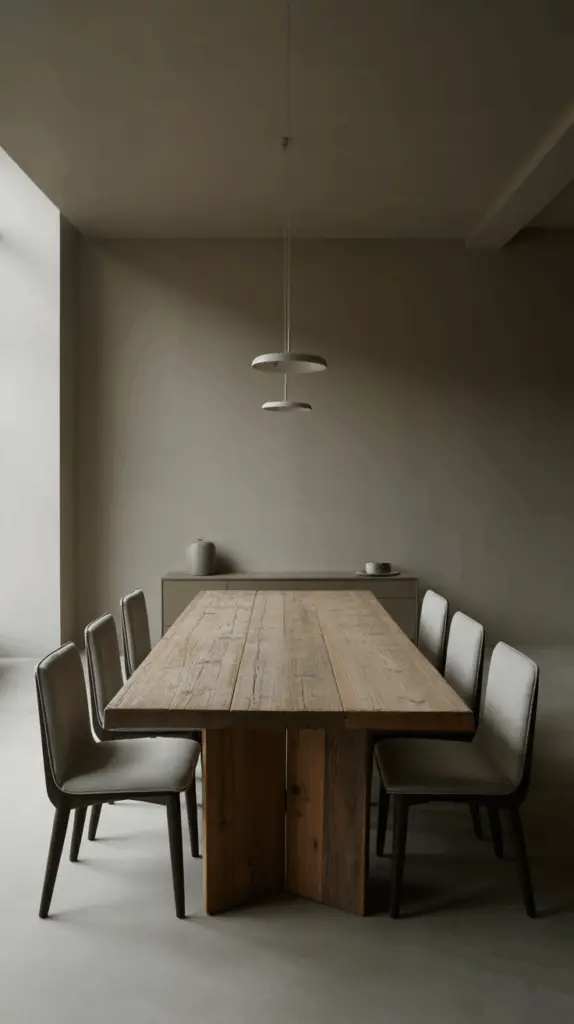Designing a Modern Organic Dining Room: A Perfect Blend of Style and Nature
Table of Contents
Introduction
In recent years, the desire to merge nature with interior design has grown exponentially, with many homeowners seeking a more natural, grounded aesthetic for their living spaces. One area that’s particularly ripe for this type of transformation is the dining room. It’s not just a place to eat—it’s where families gather, memories are made, and conversation flows. So, why not make it as inviting and peaceful as possible?
A modern organic dining room strikes the perfect balance between clean, contemporary lines and natural, earthy elements. The result is a space that feels connected to the natural world while still embracing the sleek sophistication of modern design. Whether you’re looking to revamp a dining area with a fresh perspective or start from scratch, blending natural materials with minimalist design can elevate your space into a tranquil haven.
In this blog, we’ll explore how to design a modern organic dining room, including key design elements such as color palettes, materials, furniture choices, and lighting. With a few thoughtful touches and the right inspiration, you can create a dining room that feels grounded, serene, and incredibly stylish. Let’s dive into the essentials for designing a space that balances both nature and modernity.
Choosing the Right Color Palette for a Calm, Natural Vibe
Color is one of the easiest and most effective ways to set the mood of any room, and the dining room is no exception. When designing a modern organic dining room, opt for neutral tones that mirror the calmness and tranquility of nature. Think soft beiges, muted greens, earthy browns, and warm grays. These colors work harmoniously to create a space that feels open and inviting, while maintaining a subtle connection to the natural world.
The key to making these colors work is layering. You can start with a neutral base for your walls and larger furniture pieces, then introduce accent colors through accessories like throw pillows, rugs, or artwork. For a truly organic feel, try incorporating natural green tones, which are reminiscent of foliage, or pale blues that evoke the serenity of sky and water.
To break up the monotony of solid neutral walls, consider using textures to add depth to the color scheme. Linen curtains, wool rugs, and wooden furniture all bring variety to a neutral color palette while maintaining a clean, organic aesthetic.
Table: Color Palette Ideas for Modern Organic Dining Rooms
| Primary Color | Accent Color | Mood Created |
| Soft Beige | Olive Green, Charcoal | Calm, grounding, warm |
| Light Taupe | Rust, Sage Green | Cozy, natural, inviting |
| Pale Gray | Warm Wood Tones | Clean, balanced, peaceful |
| Muted Blue | Soft Browns, Whites | Fresh, airy, harmonious |
Embrace Natural Materials and Textures
A key component of modern organic design is the use of natural materials. When designing your dining room, choose furniture, finishes, and accents made from sustainable, natural materials that will not only enhance the organic aesthetic but also contribute to a healthier indoor environment.
Wood, stone, and natural fibers are essential for this type of design. Opt for a wooden dining table with a raw or reclaimed finish to introduce a sense of authenticity and warmth. For the flooring, consider natural wood or bamboo to add texture and a grounded feel to the room. A stone feature—whether it’s a marble countertop or a stone wall—adds an earthy, luxurious touch that complements the natural theme.
Textiles also play a significant role in creating a cozy and organic vibe. Linen or cotton upholstery on dining chairs and soft, handwoven rugs provide a tactile contrast to harder materials like wood and stone, making the space feel inviting and comfortable.
Table: Natural Materials for a Modern Organic Dining Room
| Material | Use | Benefits |
| Wood | Dining table, chairs, flooring | Warmth, authenticity, natural texture |
| Stone | Countertops, feature walls, sculptures | Durability, earthiness, luxury |
| Bamboo | Flooring, blinds, accessories | Sustainable, light, natural feel |
| Linen/Cotton | Upholstery, curtains, table linens | Soft, breathable, organic look |
| Jute or Sisal | Rugs, baskets | Natural, eco-friendly, textured |

Select Minimalist Furniture for a Sleek, Modern Look
When designing a modern organic dining room, the furniture should have clean lines and a minimalist design to keep the space feeling open and uncluttered. A modern organic dining room doesn’t mean sacrificing style for comfort. Instead, it’s about striking the perfect balance between both.
Look for dining tables with simple, elegant shapes—think round or rectangular tables with a streamlined silhouette. Chairs should complement the table without overpowering it, with natural finishes and neutral upholstery to maintain the organic aesthetic. A low-profile sideboard or buffet with minimal hardware will help keep your storage needs met while maintaining a sleek look.
Avoid overly ornate pieces and instead focus on items that contribute to a harmonious, understated design. Incorporating a few sculptural or geometric elements can add visual interest without disrupting the calming, nature-inspired vibe.
Table: Furniture Choices for a Modern Organic Dining Room
| Furniture Piece | Key Features | Ideal Material/Finish |
| Dining Table | Simple, clean lines, neutral tone | Reclaimed wood, stone, bamboo |
| Dining Chairs | Minimalist design, comfortable, functional | Linen, wood, natural fibers |
| Sideboard/Buffet | Low-profile, sleek design | Natural wood, matte finishes |
| Lighting | Simple, sculptural design | Matte black, brass, or wood |
Bring Nature Indoors with Greenery
One of the simplest and most effective ways to enhance a modern organic dining room is by incorporating plants and greenery. Plants not only improve air quality but also help to create a calming, serene environment. Whether it’s a large floor plant, hanging greenery, or a small potted plant, bringing nature into your dining space can transform the room into a true oasis.
Consider adding a large statement plant, such as a fiddle leaf fig or snake plant, near the corner of the room or next to the dining table. Smaller plants like succulents or ivy can be placed on the dining table or in decorative planters scattered throughout the room. Don’t forget about vertical space—hanging planters from the ceiling or walls can add dimension while saving space.
Plants also add texture and color to the room, from the vibrant green leaves to the earthy tones of the pots they’re housed in. Whether you choose plants that are lush and full or more sculptural varieties with striking leaves, they’ll elevate your modern organic dining room.
Table: Best Plants for a Modern Organic Dining Room
| Plant | Characteristics | Best Placement |
| Fiddle Leaf Fig | Large, bold, tropical foliage | Corner, next to the dining table |
| Snake Plant | Tall, upright, low-maintenance | Near windows, entryways |
| Pothos | Cascading vines, easy care | Hanging baskets, shelves |
| Succulents | Compact, drought-tolerant, sculptural | Centerpieces, window sills |
| Peace Lily | Air-purifying, elegant white flowers | Side tables, shelves |
Incorporate Soft, Ambient Lighting
Lighting plays a significant role in setting the mood of your dining room. In a modern organic dining room, soft, ambient lighting is essential for creating a relaxing atmosphere. Instead of harsh overhead lights, opt for lighting that can be adjusted to suit different moods, whether you’re hosting a dinner party or enjoying a quiet family meal.
Pendant lights or chandeliers with natural materials such as wood, woven fibers, or matte metal finishes are perfect for a modern organic look. To create a calming ambiance, use dimmable lighting so you can control the brightness and add warmth to the room. Incorporate floor lamps or table lamps with soft, warm bulbs to add layers of light to the space.
Accent lighting, such as LED strips under cabinets or around the edges of the room, can also highlight the natural textures and materials in your dining room.
Table: Lighting Options for a Modern Organic Dining Room
| Lighting Type | Features | Ideal Placement |
| Pendant Lights | Soft, ambient light, natural materials | Above the dining table |
| Floor/Table Lamps | Additional layers of light, cozy ambiance | Near seating or in corners |
| Wall Sconces | Warm, indirect lighting, minimal design | On walls, beside art or mirrors |
| LED Accent Lighting | Subtle, modern, highlights textures | Under shelves, cabinets, or along the floor |
Conclusion
Designing a modern organic dining room is all about creating a space that feels both grounded and serene, blending nature’s elements with clean, modern design. By focusing on a calming color palette, incorporating natural materials, choosing minimalist furniture, and enhancing the space with greenery and soft lighting, you can craft a dining room that is not only visually stunning but also inviting and relaxing. Whether you’re hosting dinner parties or enjoying quiet meals with family, a modern organic dining room will offer the perfect backdrop for both everyday moments and special gatherings.

